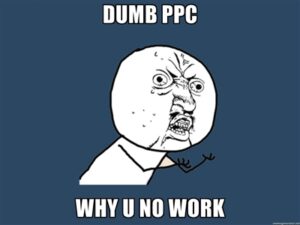 When I first started out in eCommerce back in 1994, there was no such thing as pay-per-click (PPC) advertising, the term “search engine optimization” wasn’t coined yet and there definitely wasn’t Facebook.
When I first started out in eCommerce back in 1994, there was no such thing as pay-per-click (PPC) advertising, the term “search engine optimization” wasn’t coined yet and there definitely wasn’t Facebook.
Today, if you want to get the word out about your website, you have to work hard to get organic ranking, spend a chunk of change on pay-per-click to get immediate traffic and have a social media presence among other things.
I say it over and over again, that just because you launch a website today, doesn’t mean you’re going to be overwhelmed with traffic/orders tomorrow. Building up an audience and customers takes time and plenty of patience.
But in the age of instant gratification, who has patience?
When sales are slow and inventory is piling up, many simply crank up the PPC to drive traffic with the hopes that some of those clicking on the ad will buy something.
If only that were true.
Sure you may get traffic, but chances are it’s not qualified traffic that converts into a sale. When this happens, the first thing many store owners will say, “pay-per-click doesn’t work for me.”
PPC advertising is a very viable form of effective online advertising if it’s managed properly. But pay-per-click only drives traffic, a concept many eCommerce store owners forget. I have a very simple analogy when it comes to describing what PPC is:
“PPC is the bus that drives passengers to your storefront. It’s the shop keeper’s responsibility to get them to buy.”
It’s a very simple way to look at pay-per-click, and when someone says to me “PPC doesn’t work,” I give them that analogy. If the bus drops people off at your store and they just wander around inside without making a purchase, one of two things happened:
1. The traffic wasn’t qualified. Which simply means you’re paying for people to come to your site who simply aren’t interested in purchasing. Example of this would be me paying for the search term “ferret” and paying for visits from people looking for information about the animal because they saw a special on Animal Planet, rather than from people looking to buy something for their pet.
Unqualified traffic is usually the result of a campaign that’s not managed properly or a store owner who falls into the trap of cranking up PPC spend in the hopes that it will result in more orders – an expensive trap that many fall into!
2. Something turned the shopper away. If the bus is dropping off qualified customers at your stoop and they’re not buying, you can’t blame the driver! It’s time to take a look at some common, yet overlooked items that may be to blame:
- Did you do something to the navigation structure or page layouts on your site recently that may have changed the customer experience making it more difficult for them to find an item they’re looking for? I’ve seen this happen far too many times when an add-to-cart button may blend in too much that it gets missed, or a design change forced the relocation of the “view cart” link to an obscure spot. Keeping site design simple, clean and easy to shop, add and buy should always be a priority over clutter and fancy design elements that distract.
- Were you running ads directing customers to products that are currently out of stock? This is a common occurrence that many store owners totally forget about and ends up costing them more than just money. Nothing turns me off more than clicking on an ad for a product only to find the add-to-cart button is replaced with an “out of stock” graphic.
- Are your prices competitive? Many people who are in the final purchasing phase know what a particular item sells for. If your prices are higher than your competitors and you’re not offering them any compelling offer to buy from you over someone else, this can be a factor.
This list can go on and on as there are plenty of things that can be added to it. But these top 3 are a good place to start looking if you ever hit that point where you’re scratching your head wondering why you’re spending money but not getting results.
Again, pay-per-click advertising works. It’s a great way to drive immediate traffic to your site on an ongoing basis or when you’re patiently waiting for your SEO efforts to result in organic ranking. However, left unmanaged, PPC can become as dangerous as Justin Bieber on the streets of Miami Beach. An improperly managed campaign can quickly push the limits of your gold card, resulting in tons of unqualified traffic and a return on ad spend (ROAS) that makes you want to close up shop and join the Biebs for an intervention in Panama.
